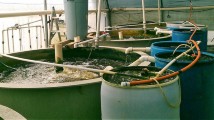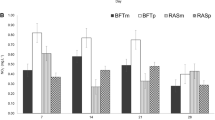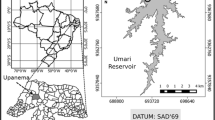Abstract
Reverse osmosis desalination is a solution for water supply in rural communities in the semi-arid region. However, the disposal of waste generated in the process has been a challenge. Thus, a study was conducted to evaluate the economic viability and development of Nile tilapia (Oreochromis niloticus) cultivated in nurseries using water support, the rejected brine from the brackish water treatment plant. The study was conducted in the rural community of Serra Mossoró, Mossoró, RN, Brazil, benefited by the “Água Doce” program with a desalination plant. For this, two nurseries were built for fish farming and a tank to receive fish effluent. Each nursery was populated with 700 male Nile tilapia fingerlings. To determine fish growth, biometric analyses of head length, partial length, total length, height, width, and average weight were performed every 30 days after stocking. The economic analysis consisted of identifying the financial inflows and outflows. The results showed that all biometric parameters increased linearly with the time of cultivation, indicating that tilapia development and production using reject brine were satisfactory, making this waste feasible in fish farming. Economically, the project proved to be unfeasible in the short term, requiring a longer execution time of the generated cash flows to cover the initial investment. Despite this, the project generated positive social and environmental impacts. The raising of tilapia is a viable alternative for draining saline waste and ensuring food and nutritional security for family farming.
Highlights
-
The use of rejected brine from desalination plants for the rearing of tilapia was tested.
-
The economic viability of the activity can only be achieved after 2 years.
-
The activity is a positive alternative to dispose of rejected brine properly.

Similar content being viewed by others
Data Availability
The datasets generated during and analyzed during the current study are available from the corresponding author on request.
References
Anders, C. R., dos SantosFernandes, C., da Silva Dias, N., da Silva Gomes, J. W., de Souza Melo, M. R., de Souza, B. G. A., Souza, A. C. M., & de Sousa Júnior, F. S. (2020). Environmental impacts of reject brine disposal from desalination plants. Desalination and Water Treatment, 181, 17–26. https://doi.org/10.5004/dwt.2020.25055
Antas, F. P. S., Dias, N. S., Gurgel, G. C. S., Miranda, N. O., Oliveira, A. M., Fernandes, C. S., Ribeiro Filho, J. C., Sousa Neto, O. N., Freitas, J. M. C., & Andrade, L. M. (2019). Analysis of recovery by desalination systems in the west of Rio Grande do Norte, Brazil. Desalination and Water Treatment, 138, 230–236. https://doi.org/10.5004/dwt.2019.23336
Antas, F. P. S., Oliveira, A. M., Dias, N. S., Freitas, J. J. R., Sousa Neto, O. N., & Lima, A. O. (2018). A proposed index to assess quality of waters from desalination plants. Revista Brasileira De Engenharia Agrícola e Ambiental, 22(10), 667–672. https://doi.org/10.1590/1807-1929/agriambi.v22n10p667-672
Bhujel, R. C. (2000). A review of strategies for the management of Nile tilapia (Oreochromis niloticus) broodfish in seed production systems, especially hapa-based systems. Aquaculture, 181, 37–59. https://doi.org/10.1016/S0044-8486(99)00217-3
Carmo, F. F., Espínola Sobrinho, J., Maia Neto, J. M. (1991). Dados meteorológicos de Mossoró (janeiro de 1989 a dezembro de 1990), Mossoró: ESAM, FGD, 110p, Coleção Mossoroense, Série C, 630
Dias, N da S, Fernandes, C dos S, Sousa Neto, O. N de, Silva, C. R da, Ferreira, J. F da S, Sá, F. V da, Cosme, C. R, Souza, A. C. M, Oliveira, A. M de, Batista, C. N de O (2021) Potential agricultural use of reject brine from desalination plants in family farming areas. In E. Taleisnik & R. S Lavado (Eds.), Saline and alkaline soils in Latin America (1a ed., p. 463). Sprinnger, Cham.
Felizatto, M.R. (2000). Reuso de água em piscicultura no Distrito Federal: Potencial para pós tratamento de águas residuárias associado à produção de pescado, 193 p. Dissertação (Mestrado em tecnologia ambiental e recursos hídricos) -, Universidade de Brasília, Distrito Federal.
Kubitza, F. (2005). Tilápia em água salobra e salgada: uma boa alternativa de cultivo para os estuários e viveiros litorâneos. Revista Panorama da Aquicultura. São Paulo, Disponível em: <http://www.panoramadaaquicultura.com.br/Paginas/Revistas/88/TilapiaAguaSalgada88.asp>. Acesso em: 28 de julho, 2021.
Kubitza, F, Kubitza, LMM. (2000). Tilápias: qualidade da água, sistemas de cultivo, planejamento da produção, manejo nutricional e alimentar e salinidade. Parte I. Jundiaí, São Paulo
Litalien, M., & Zeeb, B. (2020). Curing the earth: A review of anthropogenic soil salinization and plant-based strategies for sustainable mitigation. Science of the Total Environment, 698, 1–15. https://doi.org/10.1016/j.scitotenv.2019.134235
Mesquita, R. C. T., Maschio, D., Eloy, L., Godoy, L., da Paz, E. M., & Streit, D. P. (2016). Vantagens do cultivo de tilápia do Nilo (Oreochromis niloticus) com mínima liberação de efluentes. Revista Brasileira de Higiene e Sanidade Animal, 10(3), 447–454.
Mohamed, A. M. O., Maraqa, M., & Al Handhaly, J. (2005). Impact of land disposal of reject brine from desalination plants on soil and groundwater. Desalination, 182, 411–433. https://doi.org/10.1016/j.desal.2005.02.035
de Oliveira, A. M., da Silva Dias, N., dos Santos Fernandes, C., Gurgel, G. C., de Oliveira Miranda, N., de Freitas, J. J. R., de Souza Lemos Neto, H., da Silva, C. R., dos Santos, M. M., da Silva, M. R. F., de Sousa Sá, F. V., & da Silva, J. F. (2020). Disposal of waste brine from desalination in Eutrophic Red Argisol and Fluvic Neosol in the western Potiguar region, Brazil. Desalination and Water Treatment, 195, 213–221. https://doi.org/10.5004/dwt.2020.25889
de Oliveira, A. M., da Silva Dias, N., de Sousa Gurgel, G. C., Rabelo, L. N., de Souza Melo, M. R., & dos Santos, M. V. (2019). Impactos físico-químicos da disposição do rejeito da dessalinização das águas de poços salinos em Neossolo e Chernossolo do Oeste Potiguar. Irriga, 23(3), 413–425. https://doi.org/10.15809/irriga.2018v23n3p413-425
de Oliveira, A. M., da Silva Dias, N., de Freitas, J. J. R., Martins, D. F. F., & Rabelo, L. N. (2017). Avaliação físico-química das águas do processo de dessalinização de poços salobros e salinos em comunidades rurais do oeste potiguar. Revista Águas Subterrâneas, 31(2), 58–73. https://doi.org/10.14295/ras.v31i2.28663
Peixoto, M. L. L. F. (2015). Viabilidade financeira da produção de milho por meio do manejo integrado de pragas na Chapada do Apodi, em Limoeiro do Norte-CE. 125 p. Dissertação (Mestrado em Economia Rural) – Universidade Federal do Ceará, UFC
Sánchez, A. S., Nogueira, B. R., & Kalid, R. A. (2015). Uses of the reject brine from inland desalination for fish farming, Spirulina cultivation, and irrigation of forage shrub and crops. Desalination, 364, 96–107. https://doi.org/10.1016/j.desal.2015.01.034
Sousa, A.C. M. (2014). Manejo integrado do rejeito de dessalinização da água salobra na agricultura. 59 p. Dissertação (Mestrado em Manejo de Solo e Água) – Universidade Federal Rural do Semi-Árido, UFERSA.
Soares, T. M., da Silva, I. J. O., Duarte, S. N., & Silva, E. F. (2006). Destinação de águas residuárias provenientes do processo de dessalinização por osmose reversa. Revista Brasileira de Engenharia Agrícola Ambiental, 10(3), 730–737.
Acknowledgements
The authors would like to thank the Coordenação de Aperfeiçoamento de Pessoal de Nível Superior (CAPES) for the financial support.
Author information
Authors and Affiliations
Contributions
All authors contributed to the study’s conception and design. Material preparation and data collection and analysis were performed by Ana Cláudia Medeiros Souza, Nildo da Silva Dias, Gerson Talles Nogueira Nobre, Halysson Rubens Alves, Maria Luiza Lima Ferreira Peixoto, Cleyton dos Santos Fernandes, and Osvaldo Nogueira de Sousa Neto. The first draft of the manuscript was written by Ana Cláudia Medeiros Souza, Maria Valdiglezia de Mesquita Arruda, Márcia Regina Farias da Silva, Francisco Valfísio da Silva, and Francisco Vanies da Silva Sá. All authors commented on previous versions and approved the final manuscript.
Corresponding author
Ethics declarations
Competing Interest
The authors declare no competing interests.
Additional information
Publisher's Note
Springer Nature remains neutral with regard to jurisdictional claims in published maps and institutional affiliations.
Rights and permissions
About this article
Cite this article
Souza, A.C.M., Dias, N.d., Arruda, M.V.d. et al. Economic Analysis and Development of the Nile Tilapia Cultivated in the Nursery Using Reject Brine as Water Support. Water Air Soil Pollut 233, 8 (2022). https://doi.org/10.1007/s11270-021-05481-w
Received:
Accepted:
Published:
DOI: https://doi.org/10.1007/s11270-021-05481-w




